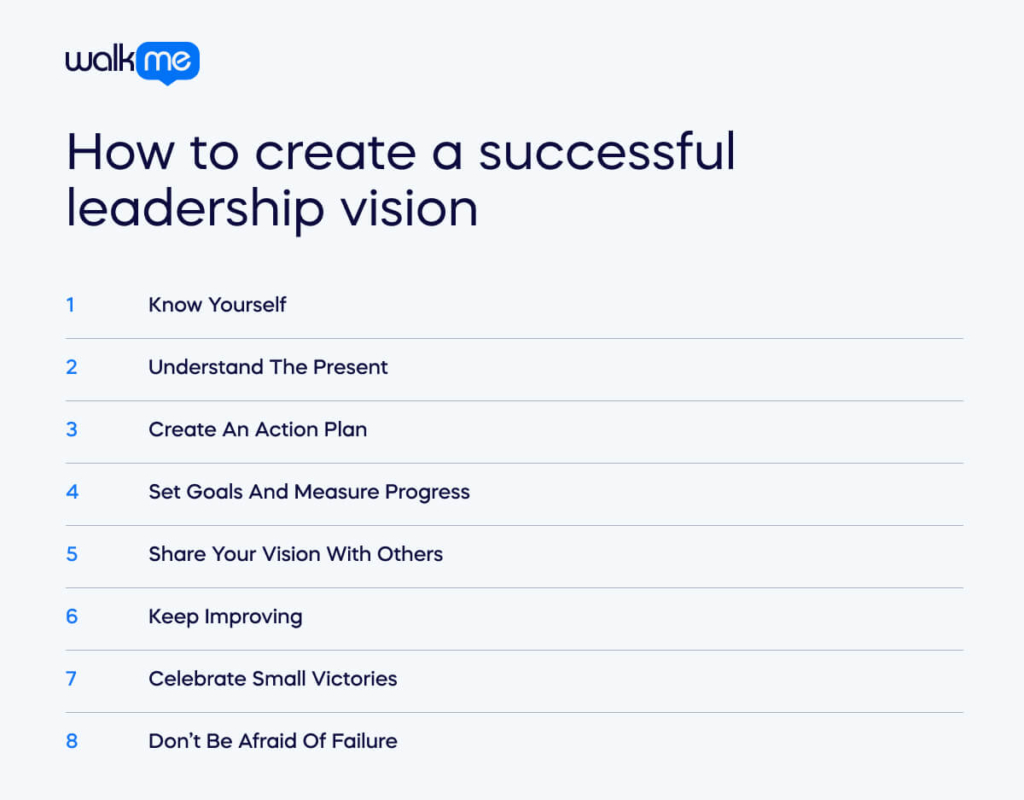A successful leadership vision is inspiring, aspirational, and achievable.
It should be something people can rally behind, believe in, and be flexible enough to adapt to change. And, of course, it must be expressed in a crystal-clear leadership vision statement.
Change leaders must be clear about their values and beliefs to create a successful change leadership vision. They also need to have a deep understanding of the current situation and the challenges that lie ahead.
Once they clearly understand the present and future, they can start articulating a vision that inspires others to follow.
Creating a successful leadership vision takes work. This article is here to help.
It will:
- Explain what a leadership vision is;
- Introduce the core components of a leadership vision statement;
- Give examples of leadership vision in practice;
- Go through the steps of how to create a leadership vision.
Powerful leadership visions can support your business goals in various ways – through change leadership, team building, and more. Read on to find out why the leader’s vision is so important.
What is a leadership vision?
A leadership vision is a leader’s overarching purpose, values, and aspirations. A leader with a strong vision can create a path to achieve the company’s desired outcomes.
A strong leadership vision is essential for any leader running complex change projects. When everything is disrupted and confusing, the vision can continue to align staff with the company values and motivate them to achieve a common goal.
An effective leadership vision statement is clear, concise, and inspiring. It should be easily understood and memorable while serving as an aspirational goal. Since the statement is a crucial component of powerful visions, we will delve into the fundamentals of crafting a compelling vision statement in the following section.
The Core components of a leadership vision statement
For most people, the leadership vision statement is an important expression of the leadership vision itself.
A leadership vision statement is a concise and inspiring declaration of a leader’s goals, values, and aspirations. It serves as a guiding beacon for the leader and their team, outlining the direction in which they want to lead their organization or group.
The core components of a leadership vision statement typically include:
- Clear Purpose
- Inspiring Vision
- Core Values
- Long-Term Goals
- Alignment with Stakeholders
- Inclusivity
- Innovation and Adaptability
- Leadership Style
- Inspiring Language
- Accountability
- Measurable Outcomes
- Communication Plan
Leadership vision statements should be concise and focused. Typically, they are no more than a few paragraphs or a page in length. It should be a living document that evolves with the organization’s needs and changes in the external environment. Additionally, it should serve as a source of motivation and guidance for both the leader and their team as they work together to achieve their common goals.
Sometimes, a leadership vision statement may align closely with a deeper set of principles. For example, agile leaders will treat the agile manifesto as their guiding vision.
Examples of leadership vision in practice
A leadership vision statement can be particularly useful in various situations to provide direction, motivation, and alignment within an organization or team.
Here are three key situations where a leadership vision statement is especially beneficial:
- A clear vision is an asset during organizational change: When an organization is undergoing significant changes, such as a merger, restructuring, or a shift in strategic direction, a leadership vision statement can provide clarity and a sense of purpose. It helps employees understand why changes are necessary and the desired future state, reducing uncertainty and resistance.
- Leaders may also use their vision for team building: When a leader is forming a new team or taking over an existing one, a vision statement can set the tone for collaboration, goal-setting, and performance expectations. It helps team members understand their roles and responsibilities and creates a shared sense of purpose, fostering teamwork and cohesion. A strong vision is one good way to improve team performance.
- Crisis Management: During times of crisis or uncertainty, a leadership vision statement can be a source of stability and hope. McKinsey research from 2025 found that nearly 50% of executives felt that crises were the most important moments for a leadership vision. It reassures employees, stakeholders, and the broader community that the leader has a plan and is committed to guiding the organization through challenges. It can also provide a rallying point for collective efforts to overcome adversity.
A well-crafted leadership vision statement is valuable for communication, motivation, and alignment. With a good vision, leaders and their teams can navigate complex and dynamic environments more effectively.
How to create a successful leadership vision

Stating a powerful leadership vision comes naturally for some people. If that’s you – there’s no need to read this section! That’s because many of us need help creating a compelling vision.
Even if you have good people skills in day-to-day work, explaining your purpose in a personal leadership vision statement requires a different skill set.
1. Know Yourself
You need to understand yourself before you can set any kind of vision. Who are you as a person? What do you stand for? What do you value most?
2. Understand The Present
Once you’ve defined your core values, you must look at the world around you. What problems exist right now? What issues are affecting the people you care about? What challenges are facing your organization?
3. Create An Action Plan
Once you have a clear idea of the present, you can start thinking about the future. What changes do you want to happen? What needs to be done to get there? This step is crucial because it gives you a sense of direction.
4. Set Goals And Measure Progress
Now that you have a clear view of the present and the future, you can begin setting goals. Think about what you want to accomplish over the next few years. Make sure each goal aligns with your vision.
5. Share Your Vision With Others
When you share your vision with others, you permit them to dream big. Inspiring people to think bigger makes them better equipped to take on new challenges and overcome obstacles.
6. Keep Improving
You need to keep improving to stay ahead of the competition. That means constantly looking for ways to improve your business or career.
7. Celebrate Small Victories
It’s easy to overlook small victories when you’re focused on achieving larger goals. But every time you succeed, you’re building momentum.
8. Don’t Be Afraid Of Failure
Focus on learning from mistakes and taking risks. Self-awareness is a key trait that successful leaders share and goes a long way in helping us to understand failures. Future-oriented leaders go above and beyond the call of duty to do the best for their organization despite the fear of failure.
Leadership Vision: Define Your Style

Part of your leadership vision is that you need to know your style, even before you’ve decided what your vision statement will look like. To help understand your approach, you should reflect on the following outline of key leadership styles. If you’re already fulfilling your company’s mission, you must understand what’s working for you.
Transformational Leadership
Transformational leadership is a leadership style that focuses on helping followers grow personally and professionally. Transformational leaders inspire employees through their personal development. They help employees discover their potential and encourage them to achieve it.
Transactional Leaders
Transactional leaders focus on results. They set expectations and hold employees accountable for meeting those expectations. Transactional leaders also reward good performance and provide feedback to employees. This type of leadership is often associated with traditional management styles.
Laissez-Faire Leadership
Laissez-faire leadership is characterized by little direction and low involvement. The leader delegates tasks and lets employees make decisions as long as the task gets done. Employees must figure out how to complete the job on their own.
Distributive Leadership
Distributive leadership involves giving people what they want. The leader provides training, support, and funding resources to help employees accomplish their goals.
Servant Leader
Servant leaders set high standards for themselves and encourage their team members to meet those same standards. Servant leaders put the needs of others before their own.
Leading Through Others
Leading through others is a form of transformational leadership that emphasizes the importance of relationships. The leader works closely with subordinates to ensure they understand what they expect.
Leading Through Objectives
Leading through objectives is a type of transactional leadership that helps employees get the job done. The leader assigns specific responsibilities and holds employees responsible for completing those tasks.
Leadership vision statements: a key to stability and growth
Although there are many parts to a successful organizational performance, visionary leaders can always make a difference in company goals.
Today’s businesses recognize this. Gartner research shows that leadership and management effectiveness continue to be a top priority for 60% of senior managers in HR.
So, there’s never a better time to develop a leadership vision, write a strong mission statement, and motivate employees through a clear statement of intention.
Frequently Asked Questions
A clear and compelling leadership vision provides direction and purpose, aligning employees with organizational goals and enhancing their commitment during transitions.
Digital transformation involves rapid changes; thus, a flexible leadership vision allows organizations to pivot strategies effectively, ensuring resilience and sustained progress.
Leaders should periodically evaluate their vision, especially when adopting new technologies like AI, to ensure alignment with evolving organizational objectives and market demands.
An ambiguous vision can lead to confusion, misalignment, and resistance among employees, undermining the effectiveness of change initiatives and organizational cohesion.
Utilizing tailored communication strategies that resonate with various departments ensures that the leadership vision is understood, embraced, and acted upon throughout the organization.

